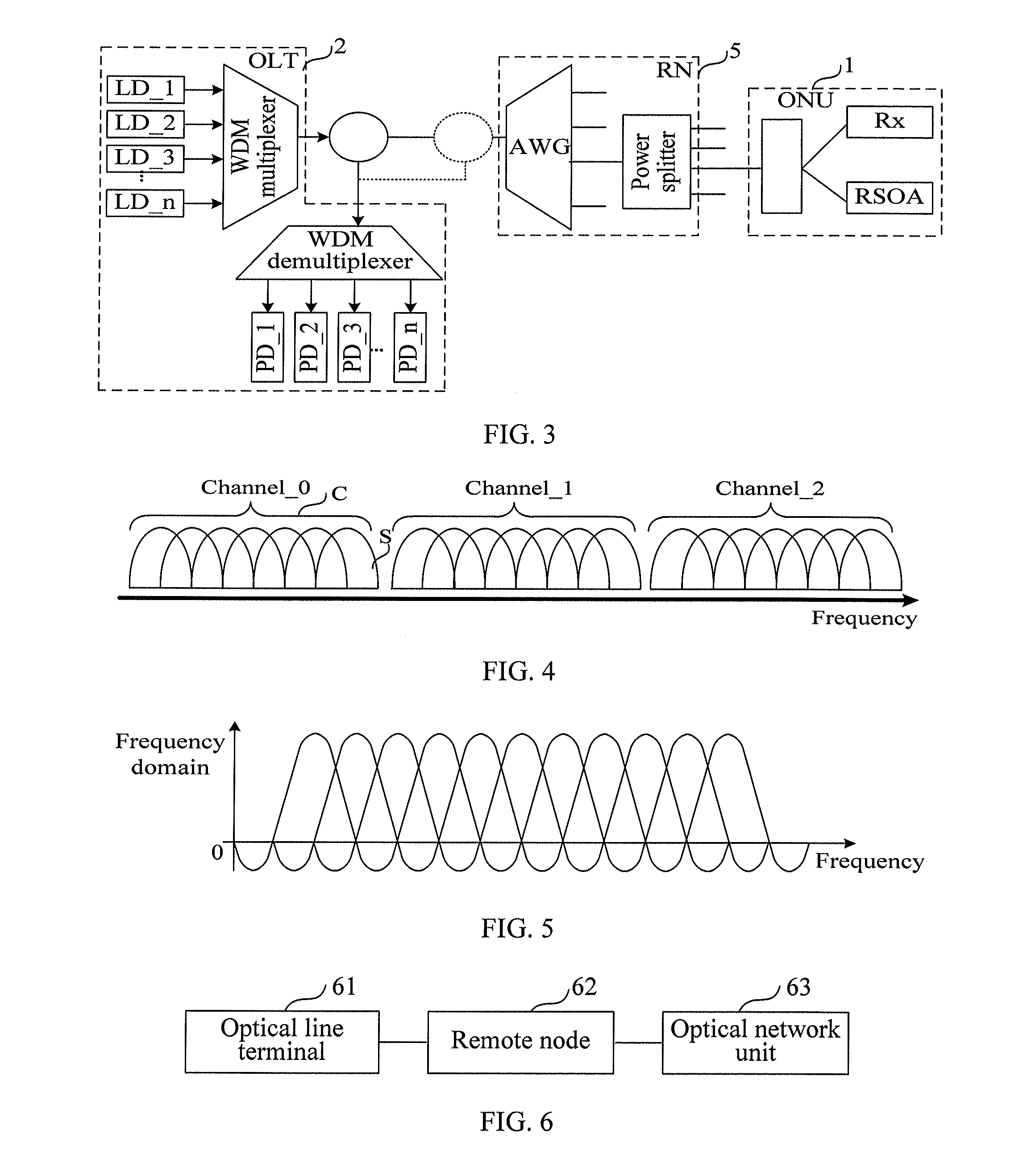Signal processing method, device, and system in a passive optical network
- Summary
- Abstract
- Description
- Claims
- Application Information
AI Technical Summary
Benefits of technology
Problems solved by technology
Method used
Image
Examples
first embodiment
[0095]FIG. 10 is a flowchart of a signal processing method in a passive optical network according to the present invention. As shown in FIG. 10, the signal processing method of the passive optical network includes the following steps.
[0096]Step 101: Perform baseband encoding processing on a received service signal.
[0097]Step 102: Modulate the service signal after baseband encoding processing onto allocated Orthogonal Frequency Division Multiple Access subcarriers through an Orthogonal Frequency Division Multiplexing modulation manner.
[0098]Step 103: Perform digital / analog conversion on the modulated Orthogonal Frequency Division Multiple Access subcarriers to obtain an electric domain Orthogonal Frequency Division Multiple Access signal.
[0099]Step 104: Modulate the electric domain Orthogonal Frequency Division Multiple Access signal onto an uplink optical signal to obtain an optical domain Orthogonal Frequency Division Multiple Access signal.
[0100]Step 105: Transmit the optical doma...
second embodiment
[0113]FIG. 11 is a flowchart of a signal processing method in a passive optical network according to the present invention. As shown in FIG. 11, the signal processing method of the passive optical network includes the following steps.
[0114]Step 201: Perform analog / digital conversion on received superposed optical domain Orthogonal Frequency Division Multiple Access signals.
[0115]Step 202: Perform Orthogonal Frequency Division Multiplexing demodulation on the signals after analog / digital conversion.
[0116]Step 203: Perform baseband decoding processing on the signals after Orthogonal Frequency Division Multiplexing demodulation to obtain service signals.
[0117]The OLT may include multiple receivers. The WDM demultiplexer of the OLT demultiplexes a multi-wavelength optical signal received from the RN into superposed optical domain OFDMA signals of different wavelengths. The receivers may receive the superposed optical domain OFDMA signals respectively; the OLT performs analog / digital (A / ...
third embodiment
[0126]The ONUs in one group share the wavelength through the OFDMA subcarriers allocated by the OLT. Specifically, different quantities of OFDMA subcarriers with different serial numbers are allocated to different ONUs in one group and the electric domain OFDMA signals on OFDMA subcarriers of the group are modulated to optical domain OFDMA signals of one wavelength. The optical domain OFDMA signals of one wavelength are then superposed by a power splitter. One or more than one OFDMA subcarrier is allocated to one ONU in the uplink. A power splitter superposes, on one wavelength, the OFDMA subcarriers of all ONUs connected with the power splitter in the frequency domain and the time domain into one OFDMA frame. FIG. 12b is a schematic diagram of OFDMA subcarriers superposed on one the same wavelength in the signal processing method of the passive optical network according to the present invention. As shown in FIG. 12b, OFDMA subcarrier A is allocated to ONU_1, OFDMA subcarrier B is a...
PUM
 Login to View More
Login to View More Abstract
Description
Claims
Application Information
 Login to View More
Login to View More - R&D
- Intellectual Property
- Life Sciences
- Materials
- Tech Scout
- Unparalleled Data Quality
- Higher Quality Content
- 60% Fewer Hallucinations
Browse by: Latest US Patents, China's latest patents, Technical Efficacy Thesaurus, Application Domain, Technology Topic, Popular Technical Reports.
© 2025 PatSnap. All rights reserved.Legal|Privacy policy|Modern Slavery Act Transparency Statement|Sitemap|About US| Contact US: help@patsnap.com



